|
|
|
Sort Order |
|
|
|
Items / Page
|
|
|
|
|
|
|
| Srl | Item |
| 1 |
ID:
114331
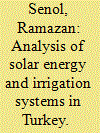

|
|
|
|
|
| Publication |
2012.
|
| Summary/Abstract |
Pumping water is considered a common need all around the world. Standalone PV technologies are being increasingly used for midsize pumping applications. PV powered pumping systems offer simplicity, reliability, and low maintenance for irrigation systems. PV powered pump is particularly appropriate for water supply in remote areas where no electricity grid is available. In this paper, the technical and economical feasibility of photovoltaic pumping of water in Turkey has been studied. Here, the study has focused on small and medium-size mobile applications using energy and water-conserving forms of drip irrigation to apple orchard on up to 0.5 ha of land in Egirdir District. Life cycle cost (LCC) method has been applied to determine the economic life of the PV modules, and the diesel pumping in Turkey taken as 25 years.
|
|
|
|
|
|
|
|
|
|
|
|
|
|
|
|
| 2 |
ID:
124221


|
|
|
|
|
| Publication |
2013.
|
| Summary/Abstract |
Feed-in Tariffs (FITs) implemented by city councils in the USA have proven an effective means of stimulating installation of renewable-electricity generation capacity at a local level, and may also be effective for New Zealand cities. Though New Zealand has a high proportion of electricity generated renewably, this is mostly from centralized hydroelectricity plants. The suitability of city-level FITs for promoting solar photovoltaic panels in New Zealand is examined. Findings suggest that FITs, with rates obtained using the cost-of-generation method, could be implemented in New Zealand cities at rates comparable to those in successful FIT schemes internationally. The unique structure of New Zealand's liberalized electricity market, however, is likely to make financing FIT schemes at city-level more complex than the equivalent situation in the USA. Benefits of introducing such schemes will include the possibility for purchasers of solar PV systems to calculate returns on investment over the long term, and the streamlining of the grid connection process by reducing the number of authorities involved.
|
|
|
|
|
|
|
|
|
|
|
|
|
|
|
|
| 3 |
ID:
169863


|
|
|
|
|
| Summary/Abstract |
This paper investigates whether capital constraints are evident for uptake of small-scale solar photovoltaic installations, using cross-sectional regressions with Australian regional data up to March 2019. There is an inverse U-shaped relationship between a number of different measures of capital and small-scale solar installations for both the 0–10 and 10–100 kW capacity categories. The positive relationship between capital and solar installations at the low end of the capital distribution suggests that capital constraints may provide an ongoing challenge for policymakers seeking to encourage the uptake of small-scale solar installations. There is also a negative association between average income and small-scale solar installations. Policymakers seeking to increase small-scale solar installations may achieve efficiency gains by targeting capital constraints rather than income constraints. An effective capital subsidy for addressing capital constraints, the Small-scale Renewable Energy Scheme, has had a substantial impact on solar uptake for systems in both the 0–10 and 10–100 kW capacity categories. In contrast, there is a lack of evidence of a substantial effect of several other policies targeting community organisations.
|
|
|
|
|
|
|
|
|
|
|
|
|
|
|
|
| 4 |
ID:
111056


|
|
|
|
|
| Publication |
2012.
|
| Summary/Abstract |
In diversifying energy supply, the transformation of the energy industry has been identified as a key challenge for a sustainable energy future. This suggests that incumbent firms in this industry have a vital role in the development and commercialization process of renewable energy technologies. This paper provides a comparative analysis of oil and gas firms' strategies regarding solar PV technology investments, a renewable energy technology that has seen explosive growth of late. The main aim is to examine the strategic approach of incumbent firms in the oil and gas industry towards the development and commercialization of solar PV technology. To investigate this, a multiple case study has been conducted within the European oil industry, focusing on the three largest oil and gas firms: BP, Royal Dutch/Shell, and Total. Findings show that oil and gas firms have difficulties with integrating solar PV technology in their supply chain. The analysis suggests that it is uncertain whether all oil and gas firms will abandon solar completely, as this depends to what extent they are able to generate profits. Nevertheless, there is currently a trend in the oil industry of leaving solar and positioning towards a 'recarbonization' of business activities.
|
|
|
|
|
|
|
|
|
|
|
|
|
|
|
|
| 5 |
ID:
132658
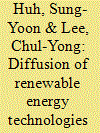

|
|
|
|
|
| Publication |
2014.
|
| Summary/Abstract |
Renewable energy technologies (RETs) have attracted significant public attention for several reasons, the most important being that they are clean alternative energy sources that help reduce greenhouse gas emissions. To increase the probability that RETs will be successful, it is essential to reduce the uncertainty about its adoption with accurate long-term demand forecasting. This study develops a diffusion model that incorporates the effect of competitive interrelationships among renewable sources to forecast the growth pattern of five RETs: solar photovoltaic, wind power, and fuel cell in the electric power sector, and solar thermal and geothermal energy in the heating sector. The 2-step forecasting procedure is based on the Bayus, (1993. Manage. Sci. 39, 11, 1319-1333) price function and a diffusion model suggested by Hahn et al. (1994. Marketing Sci. 13, 3, 224-247). In an empirical analysis, the model is applied to the South Korean renewable energy market.
|
|
|
|
|
|
|
|
|
|
|
|
|
|
|
|
| 6 |
ID:
150925


|
|
|
|
|
| Summary/Abstract |
This study models fundamental features of current and prospective policies encouraging adoption of residential photovoltaic (PV) systems. A key finding is that time-of-day (ToD) pricing can enhance or worsen the economics of PV systems. Moreover, increased responsiveness of electricity demand to its price diminishes the effectiveness of ToD pricing in the absence of net metering, but does not affect it otherwise. An application to plausible conditions in the State of Indiana, USA, shows that current policies are unlikely to trigger adoption by a risk-neutral forward-looking residential customer. However, adoption of PV systems can be induced if the Federal Tax Credit is increased to cover 48% of capital cost (instead of the current 30%), which could imply a cost to the Federal Government of about $0.95/kW of installed capacity depending on the panel’s size. We demonstrate that implementation of ToD pricing can trigger adoption under a range of on- and off-peak price combinations. But our analysis also shows that the cost-effectiveness of ToD pricing is enhanced at higher ratios of on-peak to off-peak prices.
|
|
|
|
|
|
|
|
|
|
|
|
|
|
|
|
| 7 |
ID:
110737


|
|
|
|
|
| Publication |
2011.
|
| Summary/Abstract |
This paper examines solar energy development in Malaysia, particularly in relation to the installation of solar Photovoltaic (PV) in residential houses. It analyzes the past activities related to solar energy in Malaysia, in terms of research and developments (R&Ds), the implementations used as well as the national policies for the past 20 years which have pushed the installation of PV in the country. The Feed-In Tariff (FiT) scheme is discussed, showing comparative cost-benefit analysis between the PV installation in houses in the United Kingdom (UK) and Malaysia, and with other investment schemes available in Malaysia. To investigate the awareness of renewable energy policies and incentives, a preliminary survey of the public opinion in Malaysia has been carried out, and an evaluation of public willingness to invest in the FiT scheme by installing the PV on their houses is presented. The cost-benefit analysis shows that the proposed FiT programme is capable of generating good return on investment as compared to the one in the UK, but the return is lower than other investment tools. The survey suggests that most Malaysians are unaware of the government's incentives and policies towards renewable energies, and are not willing to invest in the FiT scheme.
|
|
|
|
|
|
|
|
|
|
|
|
|
|
|
|
| 8 |
ID:
110420


|
|
|
|
|
| Publication |
2011.
|
| Summary/Abstract |
The present study aims at providing a comprehensive analysis of trade flows and the domestic value creation of the major solar photovoltaic industry at the world level. Solar technologies convert light and heat from the sun into useful energy. The use of the sun's energy can not only reduce the consumption of conventional fuels, thus reducing the emission of detrimental greenhouse gases, but it can also enable a gain in enhanced fuel and energy security along with lessening costs. In addition, green technologies and industries can promote economic growth and international competitiveness, and can offer new business and employment opportunities. It becomes, therefore, extremely important to deeply explore the dynamics of the solar photovoltaic sector. Specifically, the present work analyses the main global trends of this sector and sketches the key players on the world market, including producers, installers, and top traders. Based on an analysis of trade flows at the 6-digit level, the international specialisation patterns are investigated, and the role of various market and trade drivers, including subsidies in the uptake of solar technologies, is identified and examined.
|
|
|
|
|
|
|
|
|
|
|
|
|
|
|
|
| 9 |
ID:
114318
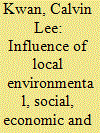

|
|
|
|
|
| Publication |
2012.
|
| Summary/Abstract |
This study used ZIP code level data from the 2000 US Census to investigate the influence of local environmental, social, economic and political variables on the distribution of residential solar PV arrays across the United States. Current locations of residential solar PVs were documented using data from the National Renewable Energy Laboratory's Open PV project. A zero-inflated negative binomial reression model was run to evaluate the influence of selected variables. Using the same model, predicted residential solar PV shares were generated and illustrated using GIS software. The results of the model indicate solar insolation, cost of electricity and amount of available financial incentives are important factors influencing adoption of residential solar PV arrays. Results also indicate the Southwestern region of the United States and the state of Florida are currently underperforming in terms of number of housing units with solar PV installations.
|
|
|
|
|
|
|
|
|
|
|
|
|
|
|
|
| 10 |
ID:
110571


|
|
|
|
|
| Publication |
2011.
|
| Summary/Abstract |
China is the largest solar photovoltaic cell producer in the world, with more than one third of worldwide production in 2008, exporting more than 95 percent of what it produces. The purpose of this paper is to understand the drivers of this success and its limits, with a particular emphasis on the role of technology transfers and innovation. Our analysis combines a review of international patent data at a detailed technology level with field interviews of ten Chinese PV companies. We show that Chinese producers have acquired the technologies and skills necessary to produce PV products through two main channels: the purchasing of manufacturing equipment in a competitive international market and the recruitment of skilled executives from the Chinese diaspora who built pioneer PV firms. The success of these firms in their market is, however, not reflected in their performance in terms of innovation. Rather, patent data highlight a policy-driven effort to catch up in critical technological areas
|
|
|
|
|
|
|
|
|
|
|
|
|
|
|
|
| 11 |
ID:
109346


|
|
|
|
|
| Publication |
2011.
|
| Summary/Abstract |
China and India are embarking on ambitious initiatives over the next decade to expand solar photovoltaic (PV) power in underserved regions. China proposes adding 1.6 GW of solar capacity by 2020, while India plans 12 GW in addition to 20 million solar lanterns by 2022. These technologies rely heavily on lead-acid batteries (LABs) for storage. China and India's lead mining, battery production, and recycling industries are relatively inefficient-33% and 22% environmental loss rates, respectively. Based on the quantity of lead batteries employed in existing PV systems, we estimate environmental lead emissions in China and India for new units installed under their solar energy goals. The average loss rates are 12 kg (China) and 8.5 kg (India) of lead lost per kW-year of installed PV capacity in these countries. The planned systems added in China and India will be responsible for 386 and 2030 kt of environmental lead loss, respectively, over their lifespan-equal to 1/3 of global lead production in 2009. Investments in environmental controls in lead smelting, battery manufacturing, and recycling industries along with improvements in battery take-back policies should complement deployment of solar PV systems to mitigate negative impacts of lead pollution.
|
|
|
|
|
|
|
|
|
|
|
|
|
|
|
|
| 12 |
ID:
105807


|
|
|
|
|
| Publication |
2011.
|
| Summary/Abstract |
Recent feed-in-tariff (FIT) programs in Ontario, Canada have elicited a very strong supply response. Within the first year of their inception, the Ontario Power Authority received applications totaling over 15,000 MW, equivalent to about 43% of current Ontario electricity generating capacity. The overwhelming share of applications is for wind-power (69%) and solar photovoltaic (28%) generating facilities. Wind generation is being remunerated at 14-19 ¢/kWh. Solar facilities receive from 40 to 80 ¢/kWh. The initiative, which responds to Provincial legislation is administratively divided into applications for facilities exceeding 10 kW (the FIT program) and those less than or equal to 10 kW (the microFIT program). This paper describes the programs and their features, compares them to their predecessors in Ontario as well as to programs elsewhere, analyses the reasons for the very strong response, and assesses their efficacy and sustainability.
|
|
|
|
|
|
|
|
|
|
|
|
|
|
|
|
| 13 |
ID:
128409


|
|
|
|
|
| Publication |
2014.
|
| Summary/Abstract |
Malaysia enacted the Renewable Energy Act in April 2011. One of its important components is the feed-in tariff (FiT) scheme-launched in December 2011. The scheme is managed and administered by the Sustainable Energy Development Authority (SEDA) of Malaysia. This paper analyses the impact of the FiT mechanism in Malaysia a year after its implementation; particularly on the installation and economical aspects. First, the history of the scheme is presented before summarising the application process for the scheme. Next, a detailed evaluation on the implication of the scheme is discussed. Some of the key findings from the analysis include: (i) the uptake for renewable energy installations has been extremely high, particularly for solar photovoltaic installation; (ii) the foreign and domestic direct investment related to renewable sectors have increased significantly; (iii) more 'green' jobs have been created, particularly in the manufacturing and installation sectors, and (iv) there are plans to include wind and thermal energy in the FiT scheme. It can be concluded that the FiT scheme in Malaysia has produced significant impact during the first year of its implementation. With a proper monitoring by SEDA and more awareness among the people, renewable energy will most likely flourish in Malaysia.
|
|
|
|
|
|
|
|
|
|
|
|
|
|
|
|
| 14 |
ID:
126550


|
|
|
|
|
| Publication |
2013.
|
| Summary/Abstract |
The paper examined the case study of the Saudi electricity sector and provided projections for energy use and respective carbon dioxide (CO2) emissions for the period 2010-2025 with and without cleaner energy technologies. Based on two sets of 20 life cycle assessment studies for carbon capture and storage and solar photovoltaic technologies, CO2 emission reduction rates were used for projecting future CO2 emissions. Results showed enormous savings in CO2 emissions, for the most likely case, year 2025 reported savings that range from 136 up to 235 MtCO2. Including low growth and high growth cases, these savings could range from 115 up to 468 MtCO2 presenting such an unrivalled opportunity for Saudi Arabia. These projections were developed as a way of translating the inherent advantages that cleaner energy technologies could provide for CO2 emissions savings. It is hoped that the results of this paper would inform energy policymaking in Saudi Arabia.
|
|
|
|
|
|
|
|
|
|
|
|
|
|
|
|
| 15 |
ID:
176821
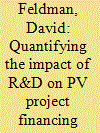

|
|
|
|
|
| Summary/Abstract |
Energy technology research and development (R&D) typically focuses on advancing the performance and reducing equipment and installation costs. However, such R&D can also have significant indirect impacts on other factors. Incorporating the impact that R&D activities have on financing costs can provide a more complete picture of the consequences of these decisions, and may allow policymakers to make better decisions. In this paper we discuss some historical examples of R&D impacting financing costs in the solar energy sector, summarize the areas of R&D that can impact financing, and describe methodological approaches that can be used to quantify the impact of R&D on financing costs and, as a result, the levelized cost of energy (LCOE). We estimate that R&D-driven reductions in financing costs in the solar sector, from current levels to low-risk levels, could reduce LCOE approximately 25%. Alternatively, without the R&D advances needed to prevent future risks and complications, financing costs in the solar sector could increase by as much as 115%.
|
|
|
|
|
|
|
|
|
|
|
|
|
|
|
|
| 16 |
ID:
117296


|
|
|
|
|
| Publication |
2013.
|
| Summary/Abstract |
The United Kingdom (UK) started implementing a national Feed-In Tariff (FiT) mechanism on the 1 April 2010, which included specific payment tariffs for solar photovoltaic (PV) installations. However, a revised FiT rate has been put in place starting from 1 April 2012, applicable to any installations with an eligibility date of on or after 3 March 2012. This paper presents, first, an overview of solar PV installation in the UK. This followed by a general concept of the FiT in the UK before analyzing the financial impact of the new FiT rate on the consumers. Similar financial analysis is conducted with selected countries in Europe. The financial analysis investigates the total profit, the average rate of return and the payback period. It is found that the new FiT rate generates very low profit, minimum rate of return and a longer payback period, suggesting a downward trend of solar PV uptake in the future.
|
|
|
|
|
|
|
|
|
|
|
|
|
|
|
|
| 17 |
ID:
186430


|
|
|
|
|
| Summary/Abstract |
A worldwide transition towards sustainable energy systems requires the diffusion of renewable electricity technologies. To achieve this, recent research has put emphasis on the role of business models as catalysts for sustainability transitions, particularly in the case of solar photovoltaics. Authors have identified a variety of solar business models that can be characterized based on roles, activities, and applications. In contrast, on the market, solar firms use business models to communicate their offer to clients, focusing on customers’ needs, how they organize their resources and activities to meet these needs and, in return, create value for themselves. The aim of this paper is to bridge the gap between the way energy policy literature describes solar business models, and the way solar firms use them to communicate with their clients. The business models of 241 solar firms in Sweden were mapped and analyzed using a framework developed by Richardson (2008) as well as the roles, activities, and applications as highlighted in solar business model literature. This led us to identify six types of solar business models. We found that there are some gaps and overlaps between theoretical and empirical solar business models which, in turn, have implications for theory and policy.
|
|
|
|
|
|
|
|
|
|
|
|
|
|
|
|
| 18 |
ID:
166575
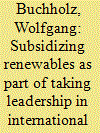

|
|
|
|
|
| Summary/Abstract |
Leadership in Climate Policy is usually associated with leading by example in mitigation efforts whereas little attention has been paid to leadership in climate-friendly technological progress. We point out that pioneering activities that create reliable demand such as Germany's feed-in tariff for solar energy constitute such technological leadership. Based on global learning curves, we argue that the enormous reduction of prices for photovoltaic modules is due to demand side interventions like Germany's EEG and related international technology diffusion and policy transfer, especially to China. For the German case, we calculate that the costs of incentivizing this technological progress through the EEG add up to a range between 112.34 and 122.18 Bn Euro (based on a thought experiment of a hypothetical new entrant in 2014).
|
|
|
|
|
|
|
|
|
|
|
|
|
|
|
|
|
|
|
|
|